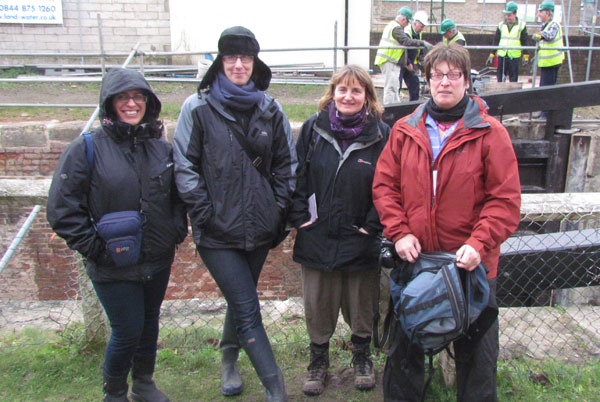In 2012, local volunteers took part in a project to record memories and stories about the Cotswold Canals as part of the first phase of the Cotswold Canals Restoration Project.
The project team invited people to share their experiences of the canal and have put together a series of audios that can be downloaded onto your smartphone to listen to when you're out walking, or listened to from the website in the comfort of your own home.
To find out more about QR codes go to 'technical stuff'.

Volunteer interviewers with Gill Chester on a visit to the canal: Dee Chaddah - Duke, Gill Chester, Fiona Eadie and Rosie Simpson.
Gill Chester and Eliza Botham launched Along the Cotswold Canals at the Stroud on Water Show in July 2012 with volunteers. Young narrators, left to right, Rhiannon Adams, Aeryn Morgan and Matt Harwood.
Rise and fall of the Cotswold Canals
The Cotswold Canals are a 37km (23 miles) long waterway, made up of two joined waterways, the Stroudwater Navigation and the River Thames & Severn Canal.
These canals once linked Britain's two great rivers and connected communities across the heart of the Cotswolds. The Stroudwater Navigation opened in 1779 to link the River Severn with Stroud. The Thames & Severn Canal opened in 1789 to connect the Stroudwater Navigation to the Thames at Inglesham, making a direct route from the River Severn to London.
The early canal engineers struggled to overcome challenges – they built locks to step up towards the summit which is (the highest point on the canal; Sapperton, the largest and longest canal tunnel of its time was built and more locks descended to the River Thames.
It's hard to imagine that this now quiet waterway was once a busy place, with boats like trows and narrowboats bringing coal to the mills and towns.
For many years the successful mills along the Stroud Valley had taken their power from the River Frome. Now that coal could be brought in by canal, they were no longer reliant on the fluctuating river and their goods could be taken away by boat. It wasn't all plain sailing as the waterways suffered from a shortage of water and were notoriously leaky. Gradually, improvements were made and the profits of the canal companies increased.
Then the railway came to town. For some time the railways had been competing with canals, but regular closures of the canals for repairs made it difficult for industry to rely on them and by 1927 the Thames & Severn Canal was formally abandoned for much of its length, the remaining length to Stroud being abandoned in 1933.
The Stroudwater Canal continued until 1941 and was finally abandoned by Act of Parliament in 1954. During the next 15 years, Sapperton Tunnel suffered collapses, sections of the canals were filled in and roads and even part of the M5 were built over the canal, effectively cutting it off from the river.
Restoration
For some years, the prevailing view was that the canals were no longer of any value and should be filled in. Gradually, a few people began to realise that these waterways could be attractive places for people to walk, fish or go boating and that these activities could bring more jobs into the area.
What started as a small meeting of enthusiasts grew into a campaign to restore the waterways as former Stroudwater Canal Society chairman, Mike Ayland explains in his interview.
Soon, the society had become the Cotswold Canals Trust and enthusiasm was pressuring the local authorities to think about whether it was better to keep a waterway than fill it in. Local volunteers began to clear and restore sections of the waterway and bring in help for other organisations.
Engineering studies showed that it would be feasible to restore the canal. In 1996, Gloucestershire County Council commissioned British Waterways to look at the costs and benefits of restoring part or all of the Cotswold Canals. Neville Nelder talks about the gradual changes in people's attitude to the canals, his interview can be found here.
Today the restoration is headed up by the Cotswold Canals Partnership and funded by Heritage Lottery Fund, County and District Councils as well as many other bodies.
The Cotswold Canals Partnership members are: The Waterways Trust; Cotswold Canals Trust; Stroud District Council; South West Regional Development Agency; Gloucestershire County Council; Wiltshire Council; Gloucestershire First; Gloucestershire Rural Community Council; Environment Agency; Gloucestershire Society for Industrial Archaeology; Learning & Skills Council; Cotswold Water Park Society; Inland Waterways Association; National Heritage Training Academy (SW); South West Tourism; Company of Proprietors of the Stroudwater Navigation and Cotswold District Council.
The Partnership's aim is to:
'Restore the Cotswold Canals to full navigation in the interests of conservation, biodiversity and local quality of life, and to use the restoration as a catalyst for wider social, economic and environmental regeneration in areas neighbouring the canals'.